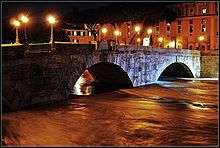Pons Cestius
| Pons Cestius (Pons Gratiani) | |
|---|---|
 The Pons Cestius in its modern form | |
| Carries | Tiber Island-Trastevere |
| Crosses | Tiber |
| Locale | Rome, Italy |
| Official name | Ponte Cestio |
| Characteristics | |
| Design | Arch bridge |
| Material | Stone |
| Longest span | 13.7 m |
| Number of spans | 3 |
| History | |
| Construction end | Between 62 and 27 BC (first stone bridge) |
 | |
The Pons Cestius (Italian: Ponte Cestio, meaning "Cestius' Bridge") is a Roman stone bridge in Rome, Italy, spanning the Tiber to the west of the Tiber Island. The original version of this bridge was built around the 1st century BC (some time between 62 and 27 BC), after the Pons Fabricius, sited on the other side of island. Both the pontes Cestius and Fabricius were long-living bridges; however, whereas the Fabricius remains wholly intact, the Ponte Cestio was partly dismantled in the 19th century, with only some of the ancient structure preserved.
The Pons Cestius is the first bridge that reached the right bank of Tiber from the Tiber Island. Whereas the island was long connected with the left bank of the Tiber and the heart of ancient Rome, even before the pons Fabricius, the right bank (Transtiber) remained unconnected until the Cestius was constructed. Several prominent members of the Cestii clan from the 1st century BC are known, but it is uncertain which of them built this bridge.[1]

In the 4th century the Pons Cestius was rebuilt by the Emperors Valentinian I, Valens and Gratian and re-dedicated in 370 as the Pons Gratiani. The bridge was rebuilt using tuff and peperino, with a facing of travertine. Some of the rebuilding material came from the demolished porticus of the nearby Theatre of Marcellus.[2]
During the building of the walls along the river embankment in 1888–1892, the bridge had to be demolished and rebuilt, as the western channel was widened from 48 to 76 meters. The ancient bridge, which had two small arches, was simply not long enough. A new bridge, with three large arches, was constructed in its stead, with its central arch reusing about two-thirds of the original material.
See also
References
- ↑ Samuel Ball Platner. "Pons Cestius (from A Topographical Dictionary of Ancient Rome)".
- ↑ Claridge, Amanda (1998). Rome: An Oxford Archaeological Guide. Oxford: Oxford Univ. Press.
Sources
- O’Connor, Colin (1993). Roman Bridges. Cambridge University Press. pp. 66f. ISBN 0-521-39326-4.
External links
![]() Media related to Pons Cestius at Wikimedia Commons
Media related to Pons Cestius at Wikimedia Commons
- LacusCurtius: Pons Cestius
- Pons Cestius at Structurae
- The Waters of Rome: Tiber River Bridges and the Development of the Ancient City of Rome
- Tiber Island information (Italian)
Coordinates: 41°53′24.8″N 12°28′38″E / 41.890222°N 12.47722°E